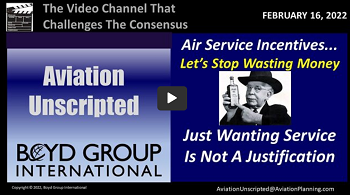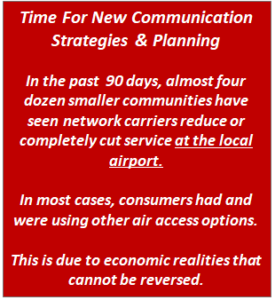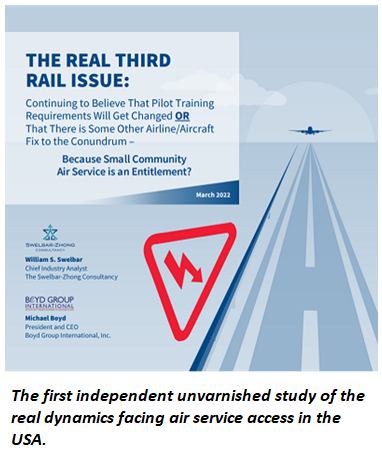Before We Start This Week:
Got Some Ideas On Aviation Future?
Here’s Your Channel.
We again want to thank the folks who are making Boyd+Swelbar Unvarnished successful… we’re hoping to inject some new perspectives into the aviation spectrum.
The next Unvarnished video will be posted February 9th. That gives you just over a week to let us know what you’d like Bill and Mike to tackle. We are open.
Tentatively, right now we’re looking at a number of Under The Wing issues that will challenge and in some cases demolish aviation groupthink. A couple of the areas we’re considering going after on February 9….
Making SCASD An Economic Program. The SCASD program is nearing 20 years old… it is based on assumptions that are now outdated, and an air transportation structure that has evolved way beyond the confines of the original program. In fact, it’s getting really out of whack compared to what small  airports need in the future.
airports need in the future.
At Boyd Group International, we’ve recognized this for the last roughly five years. After more than a decade in successful grant applications – over $23 million – we now accept very few SCASD projects – the opportunities for air service are getting more and more distant, and we don’t waste clients’ money doing applications for vapor-potential results. Plus, while it’s great for the airports involved, a lot of the grants were for communities that in no way could be described as “small” or underserved.
On the next Unvarnished, we’ll be talking about turning this program into something that reflects the new realities. It needs to be one that engenders projects that capitalize on the economic value of small airports, instead of only on the increasingly-desperate applications to find air service that in most cases won’t work. (Sorry, we’re just calling it like it is.)
There are exciting alternative uses of this money, and the US airport industry has a lot of innovation that just needs some investment dollars to implement. The focus on scheduled air service being the only #1 airport asset is flat out nonsense for small airports. It may be part of the revenue base, but there are dozens of small airports that can make hay with grants that demonstrably create jobs.
Got any ideas on the subject? Bill and Mike certainly do, and we’d be excited to hear and discuss yours? Don’t be shy… don’t hold back. Email us now. Unscripted@AviationPlanning.com.
ASD Terminology: In planning air service access, how things are categorized and described can affect how they are approached, and more importantly, how the consumer understands – or is misled – regarding the realities of air service. A couple of starters…
So, how come the word “lure” is constantly used in describing air access improvement efforts? Like, “… the mayor has a plan to lure more airlines to town…”
It implies to the consumer that airline planners are like fish that’ll jump at shiny objects. To “lure” purports that it’s just a matter of the right incentives, the right studies, and the airline will be drawn to the community in some sort of data trance. Remember, at its core, a “lure” is intended to represent something to mislead the target. Not a positive description for professional work.
The professional goal is not to “lure” but to concretely provide business reasons… clearly and succinctly… and to recognize that in some cases, they may not be there.
Then there’s the entirely obsolete definition of “catchment area” – it assumes that traffic capture is all about geography, which is complete nonsense. It’s a key concept that needs a whole new definition, based on the consumer and consumer travel needs, not an arbitrary drive-time map.
Let’s conclude these examples with the parochial concept of “leakage” which is really about consumer air service options. Contrary to groupthink, it’s not an issue of where they live, which implies that the closest airport is the one he or she should/can/must use. It’s about the air options available at the point in time the consumer wants to travel.
In fact, it can be argued that there really isn’t any true “leakage” as it is generally defined today. (That runs over the heresy line, but join us February 9 and we’ll tackle it.)
Consumers use what is best available at the time of travel, and that may be an option the local airport simply cannot offer, due to size or proximity. Determining that set of metrics is a lot more complex than doing point-of sale studies.
It is incredible how much money is spent doing “leakage” studies that are akin to taking the temperature one day, and assuming that’s what it is every day. We’ll discuss… unvarnished.
Airport Re-Purposing. As Swelbar-Zhong has pointed out repeatedly, there is going to be a lot of small jets all dressed up with no place to go as air service regionalization continues.
How much money is being thrown at trying to stop this economic reality, instead of optimizing it. With the changes evolving in air transportation and logistics, there are new economic opportunities for small airports. And it’s important that communities fully understand this dynamic.
Log On February 9… In the meantime, chime in and let us know your views. If you haven’t logged on, our channel can be accessed by clicking here. Take a look, and if you have any suggestions or input, email us at Unvarnished@Aviation.com.
___________________
Aviation Reporting: Check The Sources
There are a lot of dynamics bubbling up in aviation. Unfortunately, one of them doesn’t appear to be informed reporting.
Just came across an article about Boeing concluding the following:
“… Boeing doesn’t need to invest in a new model right away to compete with the A320 for short-haul flights, though it still needs an alternative for medium haul…”
Say, what?
Okay, somebody needs to rush off and tell those airlines running A320s on transcon and international routes that these are just “short haul” airplanes, and they’re not even “medium haul” – whatever that is. And while you’re at it, email Boeing that the 737 Max is not a viable A320 competitor, either. It was in the media, and on the internet, so it must be accurate.
This type of amateur babble is usually found on those Walter Mitty-infested internet aviation hobby boards.
But this wasn’t from one of those sources. It was from the Wall Street Journal, no less, which postures itself as expert in the subject matter, not to be questioned. It’s clear they need to be.
The Journal just also just published its ranking of best-to-worst airlines. Because it’s from a source that apparently can’t tell an A320 from a kitchen blender, it certainly should give one pause regarding the findings.
Caveat reader.
______________
And More From The Global Fleet Picture…
Anybody Noticed? It’s A Manufacturer Duopoly.
This is a first, probably.
Airbus just cancelled an order from Qatar Airways for 50 aircraft, worth over $6 billion dollars.
This is not transposed… the seller, Airbus, told the customer, Qatar Airways, to take a hike. Don’t want your business. Go someplace else. Smoke ’em if you got ’em. Buy your airliners someplace else.
The background of this is due to charges by Qatar that many of the A350s in its fleet have safety defects. It’s an allegation that just about every source – other than Qatar – has dismissed as bogus. Apparently, Airbus doesn’t need the hassle.
Want A Jet Airliner. Simple. Just Two Places To Call. On the surface, this is a business spat, and Airbus can clearly prove other A350 operators and international safety organizations are on their side.
But this isn’t the real story. It seems that IATA has looked at this Airbus cancellation and is “concerned” that there aren’t a lot of alternative airliner manufacturers out there. It’s Airbus and Boeing. Period.
The head of IATA has urged these manufacturers to behave responsibly and not abuse their market power. Clearly, if Qatar now needs narrow-body airliners, it doesn’t take much more than a GED diploma to figure out that Boeing is the only game in town. So, across the negotiating table, Qatar doesn’t have much juice. Plus, finding a compatible fleet of 50 used A320neos or 737 Max airliners is not in the cards.
Wait! The Russians Are Coming, The Russians Are Coming. The Chinese, Too! Get ready. It’s a leadpipe cinch that in the next several weeks, we’ll be hearing from a number of “expert” sources – maybe even in the Wall Street Journal – that this is the opening for China and Russia to jump into the global airliner market.
The only fly in that argument is that neither Russia nor China have any airliners worth buying. For example, China’s 75-seat or so ARJ-21 has been described by Richard Abolafia of the Teal Group as being something like “breathtakingly obsolete.” The rest of the sorry product offerings from these two nations – the MC-21, the C919, CR929 et al, aren’t far behind.
See, the machines the Russians and China’s CCP are peddling are just me-too designs and are performance dogs. Bow-wows. Flying obstacles. They’ve been on the market for years, and the case of the A320-like C919, the majority of the eager buyers are CCP-controlled financial institutions, not airlines. And none from outside of the Middle Kingdom. There’s no mystery why. (Oh, yeah. There’s an Indonesian airline that’s getting ARJ-21 lead sleds. But in the flashlight of truth, that airline is controlled by a Chinese entity.)
Consider The Owner of The Manufacturer – Any Airline Want To Become A Moral Pariah? Plus, imagine the PR mess for a US airline announcing an order for, say, C919s, direct from the government that operates concentration camps, engages in cultural genocide, and created, covered up and let spread a global pandemic. A real booking magnet, right?
 Take 8 Minutes & Get The Lowdown. We’ve done an Aviation Unscripted video covering how no matter what the backlog might be at Airbus and Boeing, airliners from China and Russia won’t get any traction outside of their own captive airlines.
Take 8 Minutes & Get The Lowdown. We’ve done an Aviation Unscripted video covering how no matter what the backlog might be at Airbus and Boeing, airliners from China and Russia won’t get any traction outside of their own captive airlines.
Click here and take a gander. The Airbus/Boeing duopoly isn’t going to see material competition.










